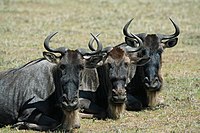Wildebeest
| Wildebeest | |
|---|---|

| |
| Blue Wildebeest | |
| Scientific classification | |
| Kingdom: | |
| Phylum: | |
| Subphylum: | |
| Class: | |
| Order: | |
| Family: | |
| Genus: | Connochaetes Lichtenstein, 1812
|
| Species | |
The wildebeest (plural, wildebeest or wildebeests), also called the gnu (pronounced /nu/ or /nju/), is an antelope of the genus Connochaetes. It is a hooved (ungulate) mammal.
Connochaetes includes two species, both native to Africa: the Black Wildebeest, or white-tailed gnu (C. gnou), and the Blue Wildebeest, or brindled gnu (C. taurinus). Gnus belong to the family Bovidae, which includes antelopes, cattle, goats, and other even-toed horned ungulates.
Wildebeest grow to 1.15–1.4 metres (3 ft 9 in–4 ft 7 in) at the shoulder and weigh 150–250 kilograms (330–550 pounds). They inhabit the plains and open woodlands of Africa, especially the Serengeti. Wildebeest can live for more than 20 years.
Behaviour
The principal food source of wildebeest is grasses. The seasonal nature of the African grasslands forces wildebeest to make annual migrations. The main migration is in May, when around 1.5 million animals move from the plains to the woods; they return in November as summer rains water the plains.
Mating typically occurs after the rainy season (around March or April) over a three-week period, and this species achieves one of the highest success rates of impregnation of all mammals, possibly because of a high state of fitness following ample rain. Gestation requires about 8.5 months, and the cows calve in summer (December to January) on the plains. The calves can walk within minutes, and after a few days can keep up with the rest of the herd. After calving, the breeding season begins again. Dominant bulls defend territories marked with feces and pheromones produced by scent glands on the heads. Subordinate males form bachelor herds.
Wildebeest are an important part of the plains ecosystem, since their dung fertilizes the soil, and their grazing and trampling encourage new growth. However, wildebeest stampedes are notorious for the amount of destruction they cause. A typical stampede often features approximately 500 wildebeest traveling at speeds of up to 50 mph (80 km/h),[1] and can last for 30 minutes. This mammal is also an important food source for predators such as lions and hyenas.
Name

The name wildebeest finds its origin in the Dutch and Afrikaans words wild and beest, which mean "wild animal" and "beest" in Afrikaans means "cattle" (or "steer"). Although the name is derived from the Dutch language, the name wildebeest doesn't officially exist in the Dutch language. The Dutch name for wildebeest is gnoe (where the Dutch "g" is pronounced [x], as in loch).

Afrikaners (Afrikaans-speaking South Africans) may have started using the name wildebeest for the animal as they had no other name for it when it was first encountered. "Gnu" is from a Khoikhoi language (which pronounced the [g]), likely an imitation of the grunting noise that a wildebeest makes.
The pronunciation of [gnuː] was popularised in English by the comic song "The Gnu" by Flanders and Swann, in which all words starting with n have a g prepended: 'I'm a g-nu, I'm a g-nu, the g-nicest work of g-nature in the zoo.'
See also
- Catoblepas (a legendary creature based on the wildebeest)
- The Great Space Coaster (children's show that featured newscaster Gary Gnu)
References
-
White bearded wildebeest at the Wildlife Ranch in San Antonio, TX
-
A grazing wildebeest
-
The wildebeest migration in the Serengeti


